Abstract
BACKGROUND--Cyclical changes in systemic blood pressure occur during apnoeic episodes in patients with obstructive sleep apnoea (OSA). Although several factors including arterial hypoxaemia, intrathoracic pressure changes, and disruption of sleep architecture have been reported to be responsible for these changes in blood pressure, the relative importance of each factor remains unclear. This study assessed the role of hypoxaemia on the increase in blood pressure during apnoeic episodes. METHODS--The blood pressure in apnoeic episodes during sleep and the blood pressure response to isocapnic intermittent hypoxia whilst awake were measured in 10 men with OSA. While asleep the blood pressure was measured non-invasively using a Finapres blood pressure monitor with polysomnography. The response of the blood pressure to hypoxia whilst awake was also measured while the subjects intermittently breathed a hypoxic (5% or 7% oxygen) gas mixture. Each hypoxic gas exposure was continued until a nadir arterial oxygen saturation (nSaO2) of less than 75% was reached, or for a period of 100 seconds. The exposure was repeated five times in succession with five interposed breaths of room air in each run. RESULTS--The mean (SD) increase in blood pressure (delta MBP) during apnoeic episodes was 42.1 (17.3) mm Hg during rapid eye movement (REM) sleep and 31.9 (12.5) mm Hg during non-REM sleep. The delta MBP during apnoeic episodes showed a correlation with the decrease of nSaO2 (delta SaO2) (r2 = 0.30). The change in blood pressure in response to intermittent hypoxia whilst awake was cyclical and qualitatively similar to that during apnoeic episodes. Averaged delta MBP at an SaO2 of 7% and 5% oxygen was 12.6 (5.7) and 13.4 (3.6) mm Hg, respectively, whereas the averaged delta MBP at the same delta SaO2 during apnoeic episodes was 38.4 (15.5) and 45.2 (20.5) mm Hg, respectively. CONCLUSIONS--The blood pressure response to desaturation whilst awake was about one third of that during apnoeic episodes. These results suggest that factors other than hypoxia may play an important part in raising the blood pressure during obstructive sleep apnoea.
Full text
PDF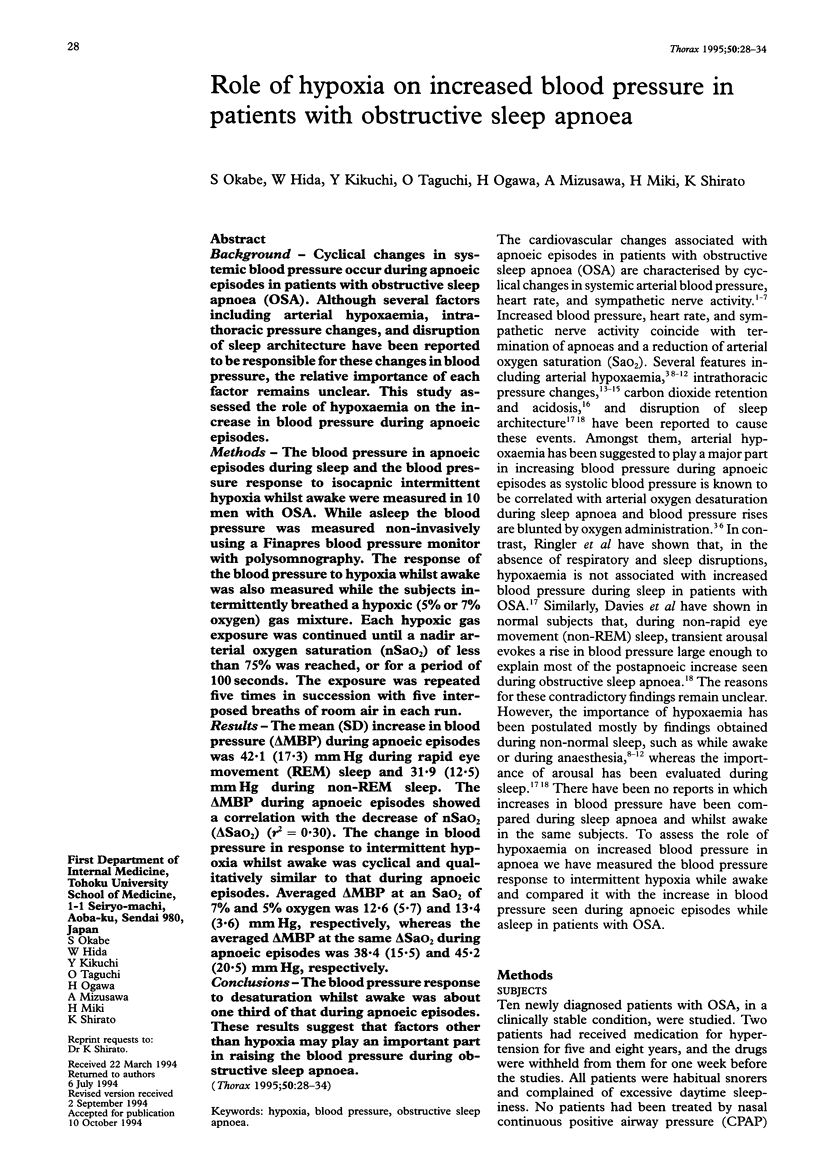
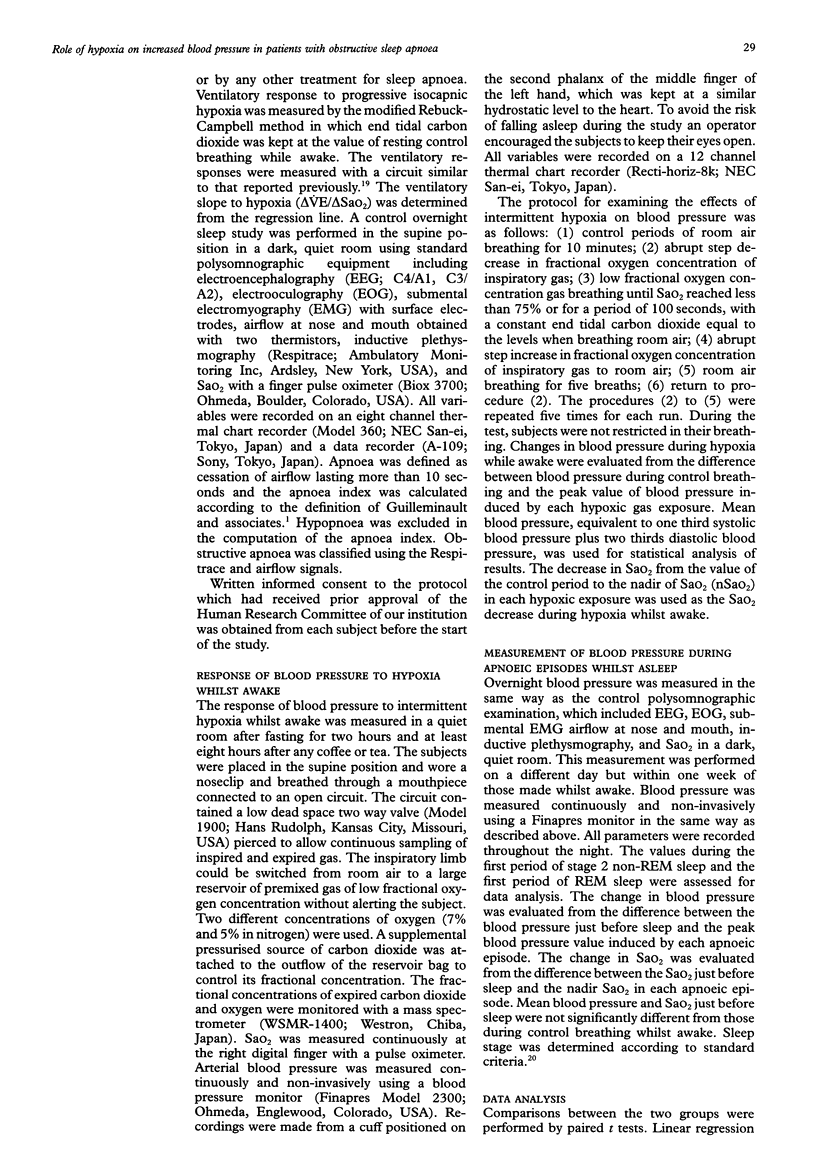
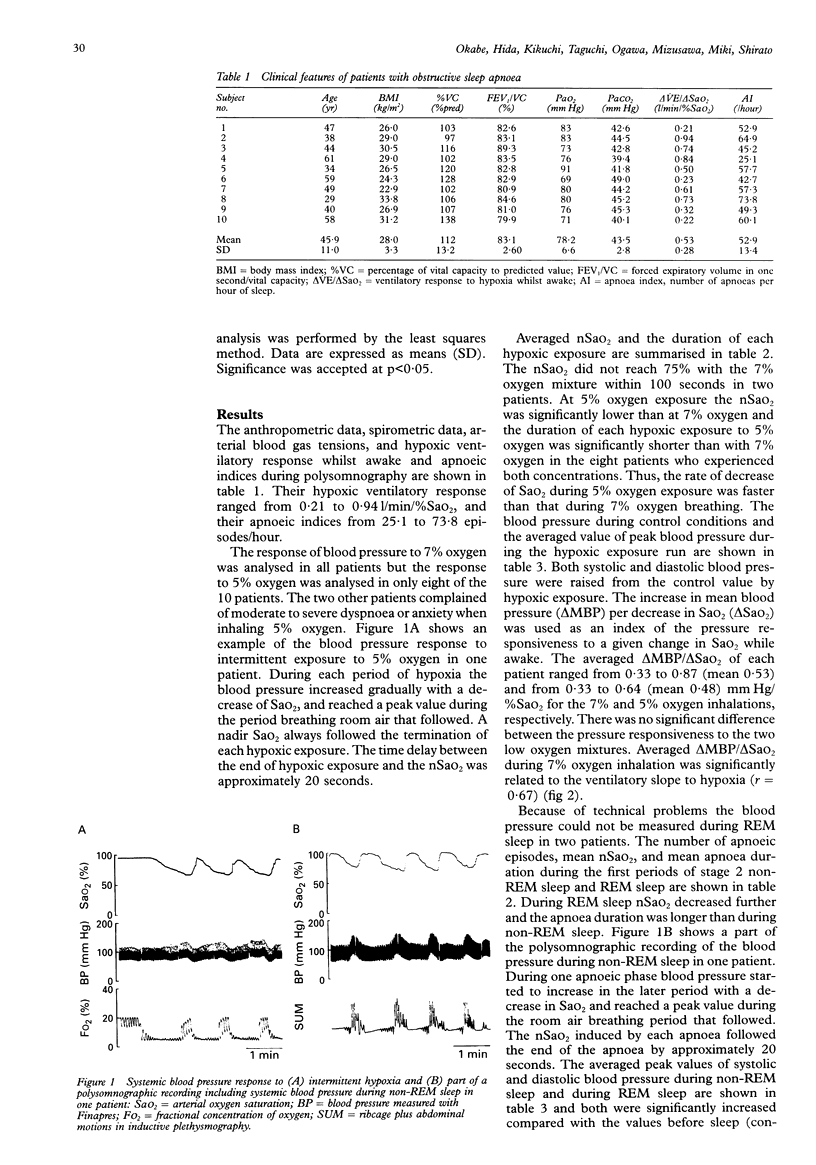

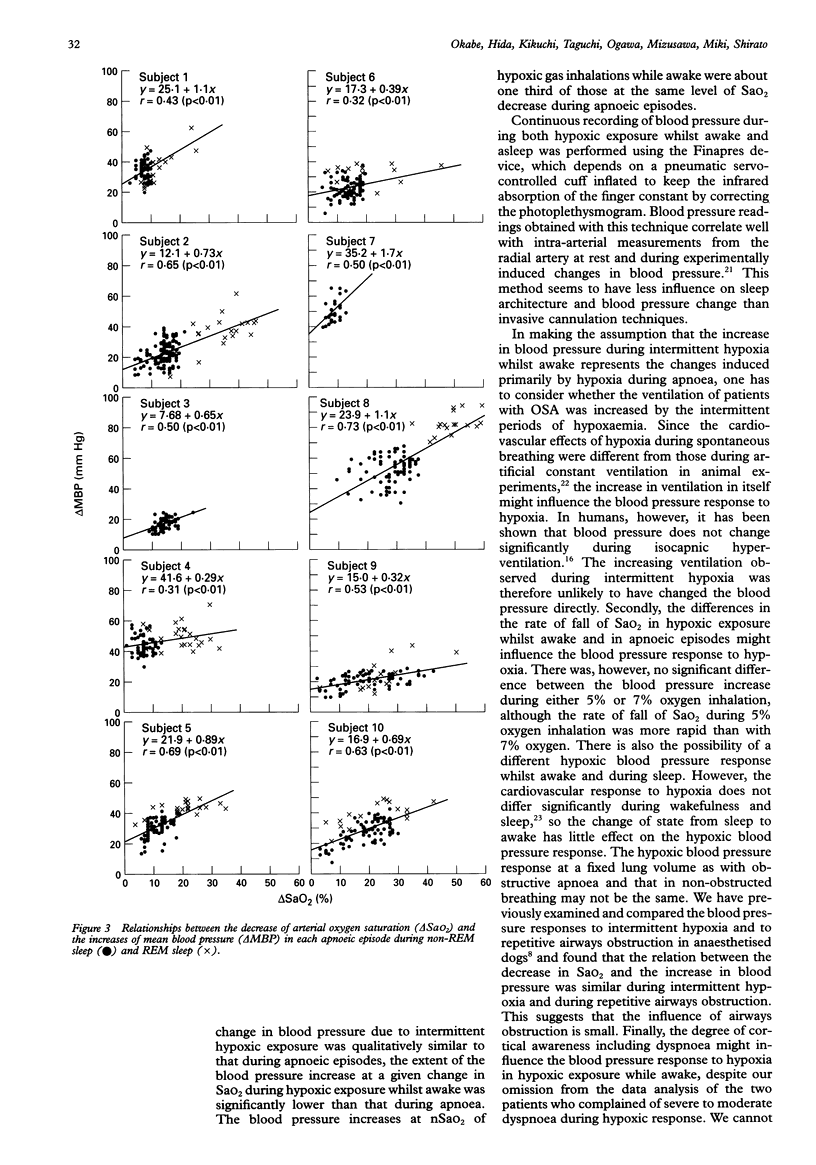
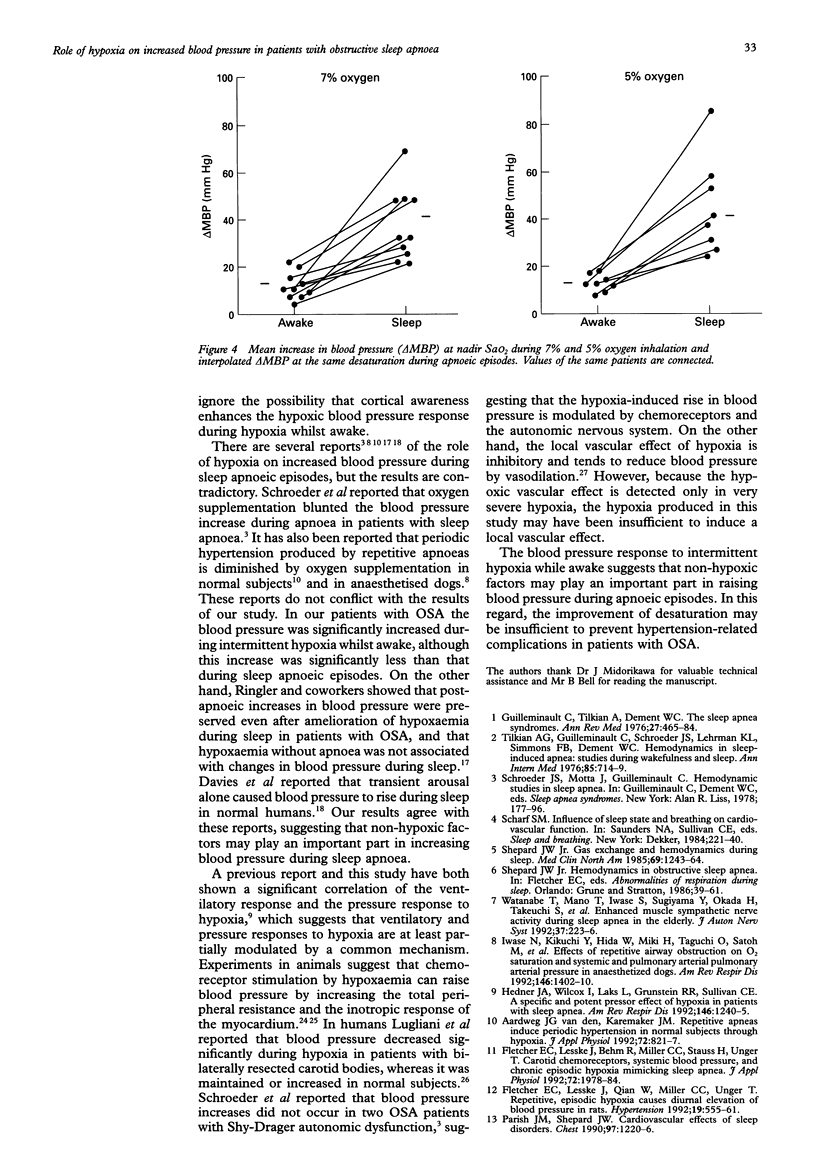
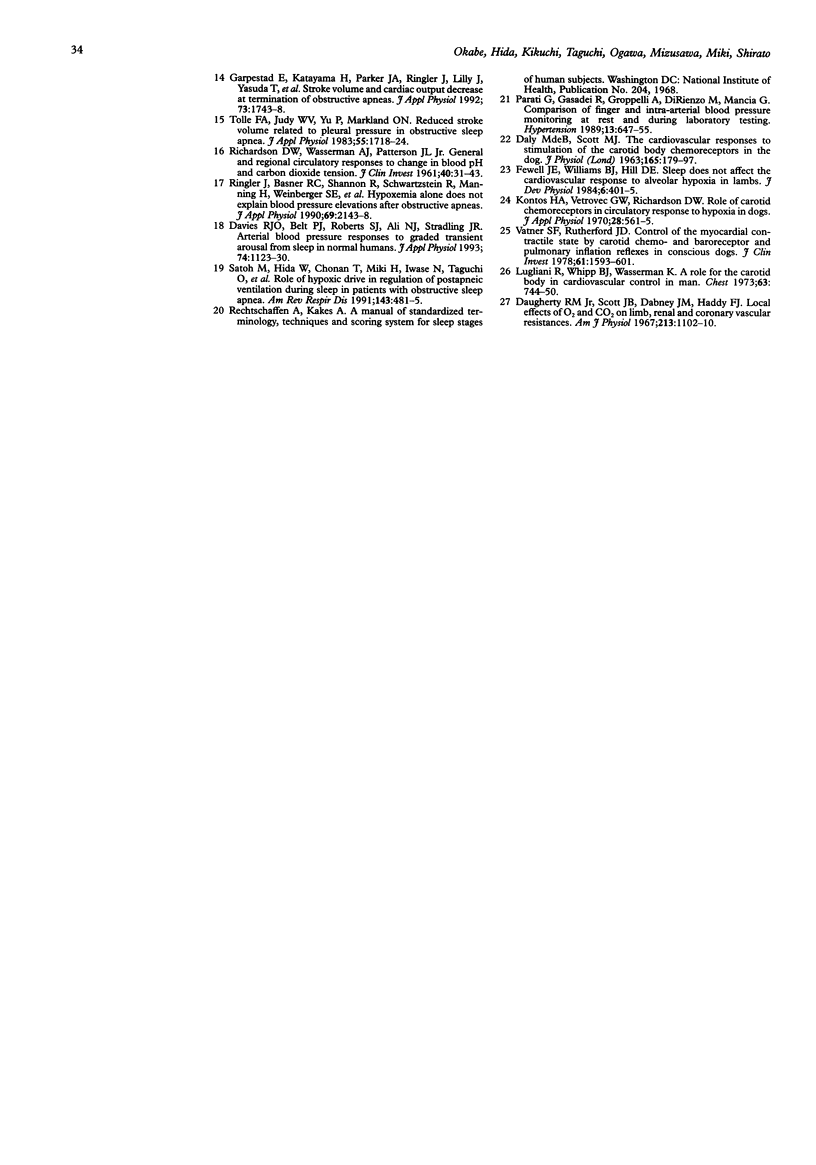
Selected References
These references are in PubMed. This may not be the complete list of references from this article.
- DALY M. D., SCOTT M. J. The cardiovascular responses to stimulation of the carotid body chemoreceptors in the dog. J Physiol. 1963 Jan;165:179–197. doi: 10.1113/jphysiol.1963.sp007051. [DOI] [PMC free article] [PubMed] [Google Scholar]
- Daugherty R. M., Jr, Scott J. B., Dabney J. M., Haddy F. J. Local effects of O2 and CO2 on limb, renal, and coronary vascular resistances. Am J Physiol. 1967 Nov;213(5):1102–1110. doi: 10.1152/ajplegacy.1967.213.5.1102. [DOI] [PubMed] [Google Scholar]
- Davies R. J., Belt P. J., Roberts S. J., Ali N. J., Stradling J. R. Arterial blood pressure responses to graded transient arousal from sleep in normal humans. J Appl Physiol (1985) 1993 Mar;74(3):1123–1130. doi: 10.1152/jappl.1993.74.3.1123. [DOI] [PubMed] [Google Scholar]
- Fewell J. E., Williams B. J., Hill D. E. Sleep does not affect the cardiovascular response to alveolar hypoxia in lambs. J Dev Physiol. 1984 Oct;6(5):401–405. [PubMed] [Google Scholar]
- Fletcher E. C., Lesske J., Behm R., Miller C. C., 3rd, Stauss H., Unger T. Carotid chemoreceptors, systemic blood pressure, and chronic episodic hypoxia mimicking sleep apnea. J Appl Physiol (1985) 1992 May;72(5):1978–1984. doi: 10.1152/jappl.1992.72.5.1978. [DOI] [PubMed] [Google Scholar]
- Fletcher E. C., Lesske J., Qian W., Miller C. C., 3rd, Unger T. Repetitive, episodic hypoxia causes diurnal elevation of blood pressure in rats. Hypertension. 1992 Jun;19(6 Pt 1):555–561. doi: 10.1161/01.hyp.19.6.555. [DOI] [PubMed] [Google Scholar]
- Garpestad E., Katayama H., Parker J. A., Ringler J., Lilly J., Yasuda T., Moore R. H., Strauss H. W., Weiss J. W. Stroke volume and cardiac output decrease at termination of obstructive apneas. J Appl Physiol (1985) 1992 Nov;73(5):1743–1748. doi: 10.1152/jappl.1992.73.5.1743. [DOI] [PubMed] [Google Scholar]
- Guilleminault C., Tilkian A., Dement W. C. The sleep apnea syndromes. Annu Rev Med. 1976;27:465–484. doi: 10.1146/annurev.me.27.020176.002341. [DOI] [PubMed] [Google Scholar]
- Hedner J. A., Wilcox I., Laks L., Grunstein R. R., Sullivan C. E. A specific and potent pressor effect of hypoxia in patients with sleep apnea. Am Rev Respir Dis. 1992 Nov;146(5 Pt 1):1240–1245. doi: 10.1164/ajrccm/146.5_Pt_1.1240. [DOI] [PubMed] [Google Scholar]
- Iwase N., Kikuchi Y., Hida W., Miki H., Taguchi O., Satoh M., Okabe S., Takishima T. Effects of repetitive airway obstruction on O2 saturation and systemic and pulmonary arterial pressure in anesthetized dogs. Am Rev Respir Dis. 1992 Dec;146(6):1402–1410. doi: 10.1164/ajrccm/146.6.1402. [DOI] [PubMed] [Google Scholar]
- Kontos H. A., Vetrovec G. W., Richardson D. W. Role of carotid chemoreceptors in circulatory response to hypoxia in dogs. J Appl Physiol. 1970 May;28(5):561–565. doi: 10.1152/jappl.1970.28.5.561. [DOI] [PubMed] [Google Scholar]
- Lugliani R., Whipp B. J., Wasserman K. A role for the carotid body in cardiovascular control in man. Chest. 1973 May;63(5):744–750. doi: 10.1378/chest.63.5.744. [DOI] [PubMed] [Google Scholar]
- Okabe S., Hida W., Kikuchi Y., Taguchi O., Ogawa H., Mizusawa A., Miki H., Shirato K. Role of hypoxia on increased blood pressure in patients with obstructive sleep apnoea. Thorax. 1995 Jan;50(1):28–34. doi: 10.1136/thx.50.1.28. [DOI] [PMC free article] [PubMed] [Google Scholar]
- Parati G., Casadei R., Groppelli A., Di Rienzo M., Mancia G. Comparison of finger and intra-arterial blood pressure monitoring at rest and during laboratory testing. Hypertension. 1989 Jun;13(6 Pt 1):647–655. doi: 10.1161/01.hyp.13.6.647. [DOI] [PubMed] [Google Scholar]
- Parish J. M., Shepard J. W., Jr Cardiovascular effects of sleep disorders. Chest. 1990 May;97(5):1220–1226. doi: 10.1378/chest.97.5.1220. [DOI] [PubMed] [Google Scholar]
- RICHARDSON D. W., WASSERMAN A. J., PATTERSON J. L., Jr General and regional circulatory responses to change in blood pH and carbon dioxide tension. J Clin Invest. 1961 Jan;40:31–43. doi: 10.1172/JCI104234. [DOI] [PMC free article] [PubMed] [Google Scholar]
- Ringler J., Basner R. C., Shannon R., Schwartzstein R., Manning H., Weinberger S. E., Weiss J. W. Hypoxemia alone does not explain blood pressure elevations after obstructive apneas. J Appl Physiol (1985) 1990 Dec;69(6):2143–2148. doi: 10.1152/jappl.1990.69.6.2143. [DOI] [PubMed] [Google Scholar]
- Satoh M., Hida W., Chonan T., Miki H., Iwase N., Taguchi O., Okabe S., Kikuchi Y., Takishima T. Role of hypoxic drive in regulation of postapneic ventilation during sleep in patients with obstructive sleep apnea. Am Rev Respir Dis. 1991 Mar;143(3):481–485. doi: 10.1164/ajrccm/143.3.481. [DOI] [PubMed] [Google Scholar]
- Shepard J. W., Jr Gas exchange and hemodynamics during sleep. Med Clin North Am. 1985 Nov;69(6):1243–1264. doi: 10.1016/s0025-7125(16)30985-3. [DOI] [PubMed] [Google Scholar]
- Tilkian A. G., Guilleminault C., Schroeder J. S., Lehrman K. L., Simmons F. B., Dement W. C. Hemodynamics in sleep-induced apnea. Studies during wakefulness and sleep. Ann Intern Med. 1976 Dec;85(6):714–719. doi: 10.7326/0003-4819-85-6-714. [DOI] [PubMed] [Google Scholar]
- Tolle F. A., Judy W. V., Yu P. L., Markand O. N. Reduced stroke volume related to pleural pressure in obstructive sleep apnea. J Appl Physiol Respir Environ Exerc Physiol. 1983 Dec;55(6):1718–1724. doi: 10.1152/jappl.1983.55.6.1718. [DOI] [PubMed] [Google Scholar]
- Vatner S. F., Rutherford J. D. Control of the myocardial contractile state by carotid chemo- and baroreceptor and pulmonary inflation reflexes in conscious dogs. J Clin Invest. 1978 Jun;61(6):1593–1601. doi: 10.1172/JCI109079. [DOI] [PMC free article] [PubMed] [Google Scholar]
- Watanabe T., Mano T., Iwase S., Sugiyama Y., Okada H., Takeuchi S., Furui H., Kobayashi F. Enhanced muscle sympathetic nerve activity during sleep apnea in the elderly. J Auton Nerv Syst. 1992 Mar;37(3):223–226. doi: 10.1016/0165-1838(92)90044-h. [DOI] [PubMed] [Google Scholar]
- van den Aardweg J. G., Karemaker J. M. Repetitive apneas induce periodic hypertension in normal subjects through hypoxia. J Appl Physiol (1985) 1992 Mar;72(3):821–827. doi: 10.1152/jappl.1992.72.3.821. [DOI] [PubMed] [Google Scholar]


